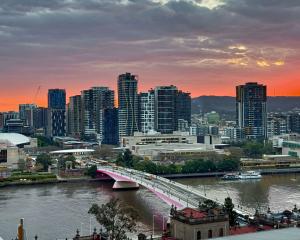There’s as much apple cake as you can eat in Holland, and also food for thought, writes Julie Orr-Wilson.
I had noted that the most common inquiry about my recent trip was, "How was the weather?" Not, "What touched you? What shocked you? What challenged you? What gave you pleasure most?" Perhaps more importantly, "How did it influence or change you?"
I am hopeful that the millions each year accruing new experiences are returning home purposeful of some greater good. What friends were gently suggesting was, for the sake of the environment, it’s time I stayed home.
I had not planned on visiting Holland, but an invitation to bike there was hard to resist.
Holland is not a country. It consists of two western provinces, Noord-Holland and Zuid-Holland. The rest, known as The Netherlands, includes our namesake, the southwest province of Zeeland. Translating to "Sealand", this watery province consists of a large number of islands and peninsulas. It’s fitting that in 1642, Dutch explorer Abel Tasman would discover our island paradise, naming it after his own.

Alongside, on Oude Hoogstraat, originally the busiest street and main arterial to Dam Square, is Amsterdam’s smallest house. Dating back to 1733, it is an exquisite miniature version of the beautiful canal houses for which Amsterdam is famous. There’s a rich history of trade: watchmaker, cigar shop, florist, boutique and residence. Now it is a tea shop, fitting only five, where I partook in the cinnamon-flavoured Dutch apple cake and house-blend Dutch Earl Grey tea. It was a reminder of the significance of spice in Holland’s history, that these bark-like, fragrant sticks could spark wars and result in the capture of kings. In 1640 the Dutch East India Company broke Portugal’s monopoly on cinnamon and by 1659 had secured its own monopoly over the trade.

The story goes that Bill Clinton desired to hang out here, his minders asking that the cafe be closed. When they refused, Bill turned up anyway, happily "gezellig" ( Dutch for the relaxed, cosy feel of being with people) with the crowd. We sought the Bruine out and were never disappointed. They run late into the night, stocking craft beers, coffee, jenever (Dutch gin), light snacks and an endless supply of fresh apple pie.
There’s no need to book cafes and canal walks, but for certainty, the Anne Frank Museum requires booking months in advance. A tourist tip is to keep looking online as daily tickets are released. Beforehand I had reread Anne’s diary. It had been difficult to release the beautiful image of that carefree girl from my mind. Less well known, but essential reading, is Miep Gies’ story, Anne Frank Remembered, The Story of the Woman Who Helped to Hide the Frank Family.

To me, it is an underwhelming memorial, "Nooit Meer", etched in glass, reads "Never Again". Nevertheless I wanted to stand and let it sink in, but we forged on. Figures, dates, facts, little hits of enormity.
Most meaningful, the Stolpersteine, stumbling stones, marking the workplace or residence, the names and dates of the people exterminated by the Nazis, initiated by German artist Gunter Demnig. In 2018 there are more than 67,000 Stolpersteine in 22 countries. A memorial can be bypassed but these little brass plaques are a confronting intrusion into everyday life. It’s welcome. Our tour finishes, lingering at the No8 tramline track, used to deport most Jews. In their memory, this will never be reinstated.

It’s uncanny how no-one speaks. As at a wake, we silently take the stairs of the annex and pass the rooms. Blackout shields the windows. The rooms are cramped and dark.
Empty too. Anne’s father, Otto Frank, insisted it was too painful to recreate the secret annex. It’s hard to imagine Anne sharing her room with the old dentist. Alongside, the bathroom that inspired her "toilet humour". From the store front windows, where the pectin business continued throughout the war, I can see the crowds of tourists milling below. Drawn to buy a postcard, I find it’s black and white, dated 1960. Otto Frank stands alone, reflective, in the annex attic. Outside, against the nondescript green, Anne Frank Huis groups are taking selfies, smiling in the sun. What else can one do?
Inspired that Anne kept a notebook, "A book of beautiful sentences", a collection of her favourite sentences copied from other writers, I resolved to keep my own. My first entry reads: "Dead people receive more flowers than the living ones because regret is stronger than gratitude." Anne Frank.
Amsterdammers, or Mokummers as they are affectionately called, were surprised we chose to spend two whole weeks in Holland. It would never seem enough. Each evening we’d take our bench on Groenburgwal canal, watching the well-dressed workers pedalling home. Canal boats with their tourists, cocktails and canapes, floating by. The bikes, with boxes, bunches of peonies on carriers, bald-headed babies in front-packs, several small children in Babboee front carriers. Most rusty, old and upright, with waterproof seat-covers and bells as big as tennis balls. "Gentle" was always the word foremost in my mind.
There are no regrets. There is enormous gratitude and I’m working on some greater good.
"I don’t want to have lived in vain like most people," writes Anne. And, for the record, it was the hottest May in 300 years.
- Julie Orr-Wilson is a Dunedin-based writer.
















